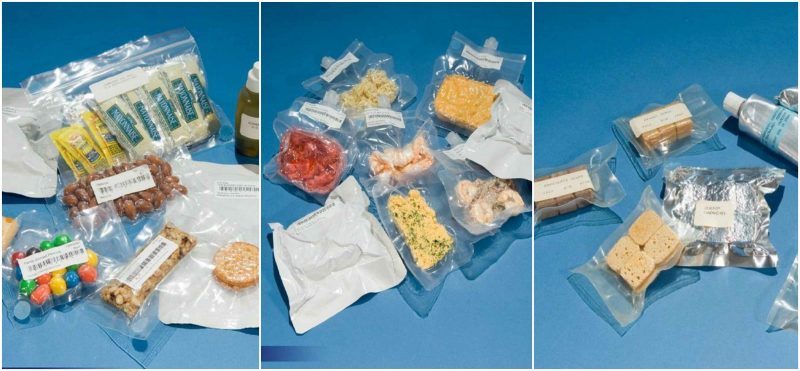Many of us may well have had a moment where we wondered to ourselves “How they do this in space?” (at least the writer of this article, with my mild space obsession, has). Now, thanks to the almighty internet, we can easily satisfy some of our space-related curiosities. For instance, how astronauts eat in space?
Well, we assume, dining in zero gravity it’s quite of an experience, but the eating options are pretty limited since a bowl of spaghetti in space maybe sounds fun but is far from doable.
![space-food-1[6]](https://www.thevintagenews.com/wp-content/uploads/sites/65/2016/07/space-food-16-640x480.jpg)
![space-food-2[6]](https://www.thevintagenews.com/wp-content/uploads/sites/65/2016/07/space-food-26-640x480.jpg)
Space food is a variety of food products, specially created and processed for consumption by astronauts in outer space. The food has specific requirements of providing balanced nutrition for individuals working in space, while being easy and safe to store, prepare and consume in the machinery-filled low gravity environments of manned spacecraft.
In recent years, space food has been used by various nations engaging on space programs as a way to share and show off their cultural identity and facilitate intercultural communication. Although astronauts consume a wide variety of foods and beverages in space, the initial idea from “The Man in Space Committee” of the Space Science Board was to supply astronauts with a formula diet that would supply all the needed vitamins and nutrients.
![space-food-3[2]](https://www.thevintagenews.com/wp-content/uploads/sites/65/2016/07/space-food-32-640x480.jpg)
Secondly, the food must be engineered for consumption in a zero gravity environment. As such, the food must be light, well packaged, fast to serve and require minimal cleaning up. (Foods that tend to leave crumbs, for example, are ill-suited for space.) Finally, the foods must require a minimum amount of effort from the astronauts; they must store well, open easily and leave little waste behind.
NASA space foods are either packaged in retort pouches or employ freeze drying. They are also packaged in sealed containers which fit into trays to keep them in place. The trays include straps on the underside, allowing astronauts to attach the tray to an anchor point such as their legs or a wall surface and include clips for retaining a beverage pouch or utensils in the microgravity environment.
![space-food-4[2]](https://www.thevintagenews.com/wp-content/uploads/sites/65/2016/07/space-food-42-640x480.jpg)
One of John Glenn’s many tasks, as the first American to orbit Earth in 1962, was to experiment with eating in weightless conditions. Some experts had been concerned that weightlessness would impair swallowing. Glenn experienced no difficulties and it was determined that microgravity did not affect the natural swallowing process, which is enabled by the peristalsis of the esophagus. All Photos by NASA
Astronauts in later Mercury missions (1959-1963) disliked the food that was provided. They ate bite-sized cubes, freeze-dried powders, and tubes of semiliquids. The astronauts found it unappetizing, experienced difficulties in rehydrating the freeze-dried foods, and did not like having to squeeze tubes or collect crumbs. Prior to the mission, the astronauts were also fed “low residual” launch-day breakfasts, to reduce the chances that they would defecate in flight.
Several of the food issues from the Mercury missions were addressed for the later Gemini missions (1965-1966). Tubes (often heavier than the foods they contained) were abandoned. Gelatin coatings helped to prevent bite-sized cubes from crumbling. Simpler rehydration methods were developed. The menus also expanded to include items such as shrimp cocktail, chicken and vegetables, toast squares, butterscotch pudding, and apple juice.0
![space-food-5[2]](https://www.thevintagenews.com/wp-content/uploads/sites/65/2016/07/space-food-52-640x480.jpg)
![space-food-6[2]](https://www.thevintagenews.com/wp-content/uploads/sites/65/2016/07/space-food-62-640x480.jpg)
Larger living areas on the Skylab space station (1973-1974) allowed for an on-board refrigerator and freezer, which allowed perishable and frozen items to be stored and made microgravity the primary obstacle.When Skylab’s solar panels were damaged during its launch and the station had to rely on minimal power from the Apollo Telescope Mount until Skylab 2 crew members performed repairs, the refrigerator and freezer were among the systems that Mission Control kept operational.
Menus included 72 items; for the first time about 15% was frozen. Shrimp cocktail and butter cookies were consistent favorites; Lobster Newburg, fresh bread, processed meat products, and ice cream were among other choices.
A dining room table and chairs, fastened to the floor and fitted with foot and thigh restraints, allowed for a more normal eating experience. The trays used could warm the food, and had magnets to hold eating utensils and scissors used for opening food containers.
The food was similar to that used for Apollo, but canned for preservation; the crew found it to be better than that of Apollo but still unsatisfying, partially due to food tasting different in space than on Earth. The frozen foods were the most popular, and they enjoyed spicy foods due to head congestion from weightlessness dulling their senses of taste and smell. Weightlessness also complicated both eating and cleaning up; crews spent up to 90 minutes a day on housekeeping.
![space-food-7[2]](https://www.thevintagenews.com/wp-content/uploads/sites/65/2016/07/space-food-72-640x480.jpg)
![space-food-9[2]](https://www.thevintagenews.com/wp-content/uploads/sites/65/2016/07/space-food-92-640x480.jpg)
![space-food-10[2]](https://www.thevintagenews.com/wp-content/uploads/sites/65/2016/07/space-food-102-640x480.jpg)
![space-food-11[2]](https://www.thevintagenews.com/wp-content/uploads/sites/65/2016/07/space-food-112-640x480.jpg)
Today, fruits and vegetables that can be safely stored at room temperature are eaten on space flights. Astronauts also have a greater variety of main courses to choose from, and many request personalized menus from lists of available foods including items like fruit salad and spaghetti. Astronauts sometimes request beef jerky for flights, as it is lightweight, calorie dense, and can be consumed in orbit without packaging or other changes.
